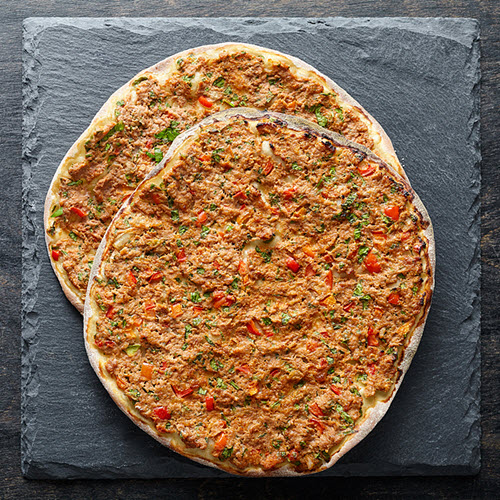 When one of my sons surprised me with a visit recently, he arrived with a gleam in his eye and a large box in hand. With a mischievous grin on his face he said: “You won’t believe what I’ve brought you for dinner.”
When one of my sons surprised me with a visit recently, he arrived with a gleam in his eye and a large box in hand. With a mischievous grin on his face he said: “You won’t believe what I’ve brought you for dinner.”
And he was right.
Wondering what he could have picked up en route, I shot him a little grin, then opened the box.
Lamejun!
My jaw dropped. I’m sure I squealed in delight. It’s rare that I have occasion to eat this much-loved meal from my childhood.
Having grown up in a land of plenty when it comes to Armenian, Greek, and Italian food, Lamejun was a family favorite, purchased at an Armenian grocery we regularly visited. I can still picture the colorful sweet and savory marvels we would bring home — apricots, pistachios, baklava, and Lamejun, this last a delectable concoction of thin crust, ground lamb, tomato, and a variety of spices.
Incidentally, this pizza-like slice of heaven has a Turkish sibling spelled Lahmacun.
As I feasted my eyes on my kiddo’s exceptionally thoughtful surprise, I was flooded with good memories. And as we sat down to enjoy our dinner, I felt transported back decades. I was suddenly relaxed, content, gleeful even; I could see the faces of childhood friends with whom I played, and my parents’ faces — so young! — at my mother’s often crowded (at times contentious) kitchen table.
While we commonly think of music as helpful in unleashing recollections we believed forgotten, “taste memory” is a powerful mechanism for recalling the past. In fact, taste combines with smell, and as this article on brain.org points out:
When these senses work together to identify chemicals in food or drink, we develop what we know as flavor. Flavor is a sensation that uses many senses at once — an amalgam of taste, texture, temperature, and smell of whatever it is we are eating.
Now, this isn’t to say that other senses aren’t invoked; we know that the best chefs understand the importance of the visual and tactile, using color, shape, and texture to enhance the experience of food placed before us.
Brain.org continues:
Though the processes behind involuntary memories are somewhat mysterious, it seems to be related to the relative locations of some key brain structures. Both the olfactory bulb and the insular cortex are closely connected to the amygdala, an area involved in emotional learning. The olfactory nerve is similarly close to the hippocampus, one of the most important brain structures for memory…
… If you become sick after consuming a particular type of food, that flavor can cause disgust or nausea every time you try to eat it again. This is called taste aversion, and it can last for years, reducing the possibility that you’ll make the same mistake twice.
Well… no taste aversion for me on the meal shared with my son!

One of the reasons my children are familiar with Lamejun, and for that matter, a number of other foods not typical where they were raised, is the natural consequence of visits both to my hometown, Boston, and parts of Europe. The European factor is a function of their dad’s origins (and regular back-and-forth to stay with grandparents), as well as my trips for business.
The result?
A diverse “food culture” that was part of our household.
Happily, both my boys have an adventurous streak when it comes to eating, which frankly by far outshines my own. I love that they love to try new foods, and I readily confess that their culinary curiosity continues to nudge me beyond my former comfort zone.
One of my sons, after spending roughly 9 months living in Switzerland as a student, came home with a few recipes of his own, having found that it was much less expensive to cook for himself than to eat out. Along with learning to make a variety of stews and casseroles, the skills to bake this stupendous dessert — Apple Sharlotka — is part of his recipe repertoire, and created a marvelous memory for me.
If you’re intrigued, The Boston Globe’s lamejun recipe looks delish. Anyone care to try their hand and report back? Any childhood foods that always put a smile on your face?
You May Also Enjoy
That looks totally delish! I am always amazed at the resistance of some people to try new and exciting tastes. Okay.. I demurred on the guinea pig while in Peru…but usually Hubby and I are game for most anything.
Recently my niece posted a shot to Facebook showing the “weird” fish and chips her husband had delivered to their table at some Caribbean resort. Fish and chips is a staple where I come from. Growing up many take-outs were fish and chip spots which happened to sell other things. But as much as I love it… I couldn’t believe they had ordered it in restaurant where they could have been trying new things. And then to add insult to injury expecting it to look like it does “at home.”
Sigh. Some people, including some people I love, just should not travel. 🙂
Yes, and I used to be one of those people. (Not any longer. The adventurous eating, not the traveling.)
Your trip was super cool to read about, Sue. What an adventure, all culinary aspects aside.
And yes, lamejun is soooooo good! And it freezes! (I still have leftovers. Mmmmmmm.)
I was born into a Spanish and Italian family. Food was always the centerpiece for conversation and sharing memories. During our evening meals we learned of our parent’s diverse histories…my father’s flight from Franco’s Spain and his ordeal to become an American…my mother’s survival of the Depression…the glue that made us a family. On snowy days, when school and work were cancelled, we gathered around the kitchen table and watched my father cook “amigas”, a batter of flour, water, one egg, garlic and salt, painstakingly fried in a deep cast iron skillet, while constantly turning and chopping the mixture until it was thoroughly cooked and resembled large panko breadcrumbs, usually taking about one hour. Topped with sardines/anchovies, and eaten with a spoon, it melted in your mouth. That was our snow day ritual…then and now, though my daughter and I take turns doing the turning and chopping, while my son-in-law makes a peanut butter and jelly sandwich.
How lovely, Angela. Thank you for sharing this.